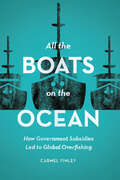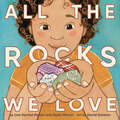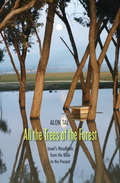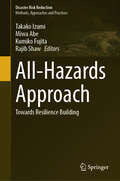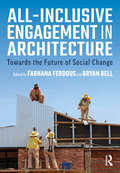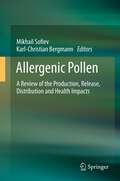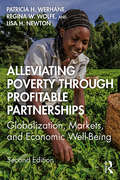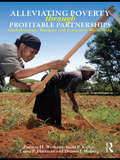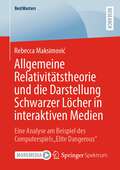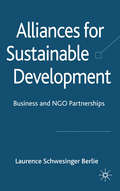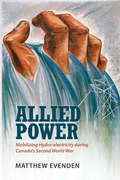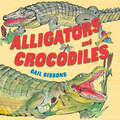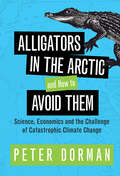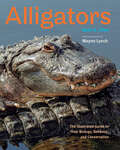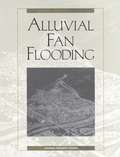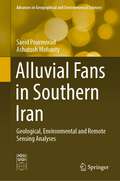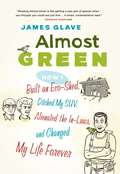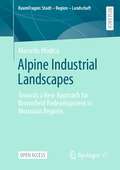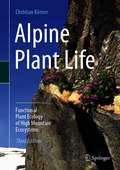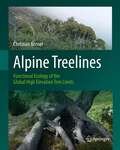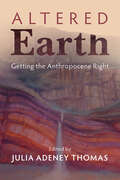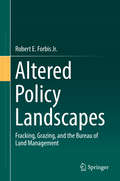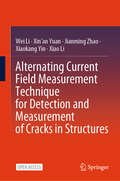- Table View
- List View
All the Boats on the Ocean: How Government Subsidies Led to Global Overfishing
by Carmel FinleyMost current fishing practices are neither economically nor biologically sustainable. Every year, the world spends $80 billion buying fish that cost $105 billion to catch, even as heavy fishing places growing pressure on stocks that are already struggling with warmer, more acidic oceans. How have we developed an industry that is so wasteful, and why has it been so difficult to alter the trajectory toward species extinction? In this transnational, interdisciplinary history, Carmel Finley answers these questions and more as she explores how government subsidies propelled the expansion of fishing from a coastal, in-shore activity into a global industry. While nation states struggling for ocean supremacy have long used fishing as an imperial strategy, the Cold War brought a new emphasis: fishing became a means for nations to make distinct territorial claims. A network of trade policies and tariffs allowed cod from Iceland and tuna canned in Japan into the American market, destabilizing fisheries in New England and Southern California. With the subsequent establishment of tuna canneries in American Samoa and Puerto Rico, Japanese and American tuna boats moved from the Pacific into the Atlantic and Indian Oceans after bluefin. At the same time, government subsidies in nations such as Spain and the Soviet Union fueled fishery expansion on an industrial scale, with the Soviet fleet utterly depleting the stock of rosefish (or Pacific ocean perch) and other groundfish from British Columbia to California. This massive global explosion in fishing power led nations to expand their territorial limits in the 1970s, forever changing the seas. Looking across politics, economics, and biology, All the Boats on the Ocean casts a wide net to reveal how the subsidy-driven expansion of fisheries in the Pacific during the Cold War led to the growth of fisheries science and the creation of international fisheries management. Nevertheless, the seas are far from calm: in a world where this technologically advanced industry has enabled nations to colonize the oceans, fish literally have no place left to hide, and the future of the seas and their fish stocks is uncertain.
All the Rocks We Love
by Lisa Varchol Perron Taylor PerronA lyrical and informative celebration of ROCKS and why we love them.Children love rocks. Rocks appear in jacket pockets, on windowsills, in the car, in their hiding places, and most often, in their little grips. Rocks are universal – they can be found in all climates, countries, and communities – making themselves available to anyone who craves the tactile pleasure of holding a perfectly sized, unfragile, unowned object. They can be collected, compared, stacked, plunked into water, painted, and shared. This book is an appreciation of their versatility and appeal, paired with the presentation of real types of rocks and their play-worthy attributes. The backmatter provides just enough extra information about each of the rocks included in the book. Written by a children&’s author and psychotherapist, in partnership with her geologist husband, and illustrated with both warmth and accuracy, this nonfiction ode to rocks will speak to all little hands and hearts.
All the Trees of the Forest
by Alon TalIn this insightful and provocative book, Alon Tal provides a detailed account of Israeli forests, tracing their history from the Bible to the present, and outlines the effort to transform drylands and degraded soils into prosperous parks, rangelands, and ecosystems. Tal’s description of Israel’s trials and errors, and his exploration of both the environmental history and the current policy dilemmas surrounding that country's forests, will provide valuable lessons in the years to come for other parts of the world seeking to reestablish timberlands.
All-Hazards Approach: Towards Resilience Building (Disaster Risk Reduction)
by Rajib Shaw Takako Izumi Miwa Abe Kumiko FujitaThis book presents case studies of risk management of various hazards and risk management systems at regional, national, and local levels. It also proposes a comprehensive approach to reduce future risks by collaborating with various stakeholders and preparing for the most effective responses toward complicated hazards, minimizing social damage.The COVID-19 pandemic has increased the concern as well as interest in the diversification of future risks and the complexity of the damage and impact that multiple risks may cause. These hazard risks include not only natural hazards, but also biological, industrial, and nuclear hazards along with other risks such as cyber-attacks, climate change, food security, conflict, and multiple hazards occurring simultaneously.The Sendai Framework for Disaster Risk Reduction, adopted in 2015 at the United Nations World Conference on Disaster Risk Reduction, accounts for the risks caused by natural or manmade hazards as well as related environmental, technological, and biological hazards and risks. The framework guides the multi-hazard management of disaster risk in development at all levels and sectors. However, in the current disaster management system in most countries, different offices are responsible for each different hazard, making it extremely difficult to manage those hazard risks comprehensively.Having experienced the COVID-19 pandemic, it is now time to review the current risk management strategy and system, and thereafter discuss how to strengthen and transform our risk perception and manner of risk assessment and identification to tackle future multiple hazards. Simultaneously, further collaboration among experts from different backgrounds and fields will become indispensable. While the discussion of the need for an “all-hazards approach” has taken place for many years, there now needs to be discussion of a risk-focused framework.
All-Inclusive Engagement in Architecture: Towards the Future of Social Change
by Farhana Ferdous and Bryan BellShould all-inclusive engagement be the major task of architecture? All-Inclusive Engagement in Architecture: Towards the Future of Social Change presents the case that the answer is yes. Through original contributions and case studies, this volume shows that socially engaged architecture is both a theoretical construct and a professional practice navigating the global politics of poverty, charity, health, technology, neoliberal urbanism, and the discipline's exclusionary basis. The scholarly ideas and design projects of 58 thought leaders demonstrate the architect's role as a revolutionary social agent. Exemplary works are included from the United States, Mexico, Canada, Africa, Asia, and Europe. This book offers a comprehensive overview and in-depth analysis of all-inclusive engagement in public interest design for instructors, students, and professionals alike, showing how this approach to architecture can bring forth a radical reformation of the profession and its relationship to society.
Allergenic Pollen: A Review of the Production, Release, Distribution and Health Impacts
by Mikhail Sofiev Karl-Christian BergmannThis is the first book to summarize all aspects of allergenic pollen: production, atmospheric distribution, and health impacts, as well as the means of monitoring and forecasting these phenomena. Based on a four-year effort by a large group of leading European scientists, this book highlights the new developments in research on allergenic pollen, including the modelling prospects and effects of climate change. The multidisciplinary team of authors offers insights into the latest technology of detection of pollen and its allergenic properties, forecasting methods, and the influence of allergenic pollen on the population. The comprehensive coverage in this book makes it an indispensible volume for anyone dealing with allergenic pollen worldwide. Readers involved in environmental health, aerobiology, medicine, and plant science will find this book of interest.
Alleviating Poverty Through Profitable Partnerships 2e: Globalization, Markets, and Economic Well-Being
by Patricia H. Werhane Lisa H. Newton Regina WolfePoverty is an unnecessary form of human degradation and badly conceived economics. Our thesis is that poverty can be reduced, if not eradicated, both locally and globally. But this will occur only if we change our shared narratives about global free enterprise, remind ourselves that poverty is a system, and conceive of poverty alleviation as a "bottom up" project. There is no "one size fits all" for poverty reduction. Rather, poverty is a system and must be addressed locally. It is our aim, as it is the aim of the United Nations, the World Bank, and many other organizations, to erase it from our vocabulary and from this planet. With a series of case studies that accompany each chapter, this book should assist readers in thinking about poverty alleviation from a number of perspectives, from bottom-up entrepreneurial projects, local-corporate ventures, with public-private partnerships, from focused philanthropy, with education and health care initiatives, and agriculture reforms in rural communities, all with creating a win-win for local and partnership individuals, organizations, and communities.. The book should be useful in various undergraduate and graduate courses on ethics, applied ethics. developing economic systems, and on poverty.
Alleviating Poverty Through Profitable Partnerships: Globalization, Markets, and Economic Well-Being
by Patricia H. WerhaneIn this book, the authors approach poverty alleviation from an atypical perspective. The thesis is that poverty can be reduced, if not eradicated, both locally and globally, but this will occur only if we change our shared narratives about global free enterprise, and only if we recalibrate our mindsets regarding how poverty issues are most effectively addressed. They argue that poverty amelioration cannot be effected by the traditional means employed during the last century—foreign aid from developed nations and/or from non-profit international organizations. Rather, the authors present evidence which demonstrates that a mindset embracing initiatives developed by global corporations in response to the poverty challenge is significantly more effective. Global companies can alleviate poverty by seizing market opportunities at the Base of the economic Pyramid (BoP) with the implementation of three key processes: moral imagination, systems thinking, and deep dialogue. This approach to alleviating poverty offers some powerful ideas backed by the support of some of the leading Business Ethics minds in the United States. These scholars, some of whom are on the author team, have created a book that is unique and provocative yet still ideal for courses at the undergraduate level.
Allgemeine Relativitätstheorie und die Darstellung Schwarzer Löcher in interaktiven Medien: Eine Analyse am Beispiel des Computerspiels „Elite Dangerous“ (BestMasters)
by Rebecca MaksimovićDie Darstellungen von Schwarzen Löcher in Büchern, im Fernsehen und in Computerspielen prägen die Vorstellungen der Öffentlichkeit über Astrophysik und die Allgemeine Relativitätstheorie (ART). Deshalb stellt sich die spannende Frage, inwiefern die Darstellungen der Wissenschaft entsprechen. Das vorliegende Buch geht dieser Frage nach, indem zwei Effekte der ART an Schwarzen Löchern, die Lichtablenkung und die gravitative Rotverschiebung, exemplarisch in dem Computerspiel „Elite Dangerous“ untersucht werden. Dafür wird zuerst die ART elementar eingeführt und auf Grundlage der Theorie werden schwarze Löcher und ihre Effekte beschrieben. Danach wird dieses Fachwissen auf Bildausschnitte des Computerspiels angewendet und diese untersucht. Ein besonderes Augenmerk wird dabei auf eine möglichst nachvollziehbare kleinschrittige Darstellung mit anschaulichen Beispielen gelegt, sodass die Arbeit auch für Lehramtsstudierende und Lehrkräfte gut verständlich ist.
Alliances for Sustainable Development: Business and NGO Partnerships
by Laurence Schwesinger BerlieA lively and hands-on exploration of corporate-NGO alliances. It offers original insight to understand why alliances exist and to what end. It also looks into the asymmetries between partners and dwells on three crucial aspects of alliances management : alliance capacity development, stakeholder involvement and alliance metrics.
Allied Power
by Matthew EvendenCanada emerged from the Second World War as a hydro-electric superpower. Only the United States generated more hydro power than Canada and only Norway generated more per capita. Allied Power is about how this came to be: the mobilization of Canadian hydro-electricity during the war and the impact of that wartime expansion on Canada's power systems, rivers, and politics.Matthew Evenden argues that the wartime power crisis facilitated an unprecedented expansion of state control over hydro-electric development, boosting the country's generating capacity and making an important material contribution to the Allied war effort at the same time as it exacerbated regional disparities, transformed rivers through dam construction, and changed public attitudes to electricity though power conservation programs.An important contribution to the political, environmental, and economic history of wartime Canada, Allied Power is an innovative examination of a little-known aspect of Canada's Second World War experience.
Alligator and Crocodile Rescue
by Trish SnyderFrom the Book jacket: Loathed for their dining habits and adored for their skins, alligators and crocodiles were hunted almost to extinction. But thanks to some creative conservation efforts, their status has improved dramatically. Even so, they are still at risk: eight species remain on the endangered list, and some hover on the edge of extinction. In Alligator and Crocodile Rescue, you'll meet people from around the world who are helping to ensure a future for these living links to dinosaurs. Trish Snyder has been an editor at Today's Parent, Chatelaine and House and Home. An award-winning writer, her articles have appeared in Toronto Life, Canadian Business, MoneySense and Glow. Alligator and Crocodile Rescue is her first book.
Alligators and Crocodiles (Live Oak Media Ereadalong Ser.)
by Gail GibbonsDo you know the difference between alligators and crocodiles...?Alligators and crocodiles are the world's largest reptiles and the closest living relatives of dinosaurs. In this extremely interesting nonfiction picture book, Gibbons compares the two reptiles by giving facts about both--their physical differences, what they eat, where they are found, how fast they swim how they raise their young, and more.Kids will want to read this book again and again to learn all about these crocodilians that have been around for millions of years. A great read-alound for the interested child or non-fiction resource for older children.Drawings are labeled throughout with additional information.
Alligators in the Arctic and How to Avoid Them: Science, Economics and the Challenge of Catastrophic Climate Change
by Peter DormanClimate change is a matter of extreme urgency. Integrating science and economics, this book demonstrates the need for measures to put a strict lid on cumulative carbon emissions and shows how to implement them. Using the carbon budget framework, it reveals the shortcomings of current policies and the debates around them, such as the popular enthusiasm for individual solutions and the fruitless search for 'optimal' regulation by economists and other specialists. On the political front, it explains why business opposition to the policies we need goes well beyond the fossil fuel industry, requiring a more radical rebalancing of power. This wide-ranging study goes against the most prevalent approaches in mainstream economics, which argue that we can tackle climate change while causing minimal disruption to the global economy. The author argues that this view is not only impossible, but also dangerously complacent.
Alligators: The Illustrated Guide to Their Biology, Behavior, and Conservation
by Kent A. VlietThe ultimate guide to understanding the biology and behavior of the amazing and underappreciated American alligator.Few scenes put the senses on edge more than a submerged alligator, only eyes and snout showing, when peering across a southern lake on a misty morning. An iconic American predator, these reptiles grow to thirteen feet or more and can live as long as humans. Alligators are complex creatures, capable of terrific attacks and yet tending to their young in the same gentle way a mother duck looks after her brood. Once extremely numerous, alligators came close to extinction in the twentieth century, but thanks to conservation efforts have since made a comeback, reclaiming their rightful place as the monarchs of the southern wetlands.In this fascinating account, richly illustrated with more than 150 photographs from award-winning wildlife photographer Wayne Lynch, expert zoologist Kent A. Vliet introduces readers to the biology, ecology, and natural history of the American alligator. Sharing nuanced depictions of their hidden lives that will forever change the way you think of these giant reptiles, the book• combines captivating storytelling with the most current scientific facts• chronicles the life cycle of the alligator• explains why the alligator's precise anatomy and physiology make it so successful• covers a wide range of topics, from courtship and reproduction to communication, basking, nest-building, and hunting• reveals the alligator's sophisticated social life in detail• evaluates the alligator's environmental role as a keystone species• examines the complicated relationship between alligators and people
Alluvial Fan Flooding
by Committee on Alluvial Fan FloodingAlluvial fans are gently sloping, fan-shaped landforms common at the base of mountain ranges in arid and semiarid regions such as the American West. Floods on alluvial fans, although characterized by relatively shallow depths, strike with little if any warning, can travel at extremely high velocities, and can carry a tremendous amount of sediment and debris. Such flooding presents unique problems to federal and state planners in terms of quantifying flood hazards, predicting the magnitude at which those hazards can be expected at a particular location, and devising reliable mitigation strategies. Alluvial Fan Flooding attempts to improve our capability to determine whether areas are subject to alluvial fan flooding and provides a practical perspective on how to make such a determination. The book presents criteria for determining whether an area is subject to flooding and provides examples of applying the definition and criteria to real situations in Arizona, California, New Mexico, Utah, and elsewhere. The volume also contains recommendations for the Federal Emergency Management Agency, which is primarily responsible for floodplain mapping, and for state and local decisionmakers involved in flood hazard reduction
Alluvial Fans in Southern Iran: Geological, Environmental and Remote Sensing Analyses (Advances in Geographical and Environmental Sciences)
by Ashutosh Mohanty Saeid PourmoradThis book presents a complete set of studies of alluvial fan sediments in southern Iran from the point of view of sedimentology, sedimentary geochemistry, tectonics, economic geology, groundwater, geomorphology, hazards and telemetry. In addition, the book focuses on advanced topics and theory, which practically serves as a model for the study of this type of sediment around the world.Alluvial fans are an important and fundamental factor in many sciences such as geology, environmental science, natural hazards, groundwater science, agriculture and many other related sciences. Lack of accurate knowledge of their constituent sediments has always been an important problem for experts in many science disciplines. From the economic point of view, the identification of alluvial fan deposits is of particular importance. For example, alluvial deposits are the centre of groundwater accumulation, and most groundwater reservoirs within the sedimentary basin are fed by water from alluvial deposits. Most of the gold production in South Africa has been formed as placer deposits in ancient alluvial fans. In addition, a large amount of uranium placer deposits is extracted from old alluvial fans in sedimentary basins in South Africa. This book serves as an ideal guide for experts in earth and environmental sciences and hydrology.
Almost Anywhere: Road Trip Ruminations on Love, Nature, National Parks, and Nonsense
by Krista SchlyerWhat do you do when your world ends? At twenty-eight years old, Krista Schlyer sold almost everything she owned and packed the rest of it in a station wagon bound for the American wild. Her two best friends joined her--one a grumpy, grieving introvert, the other a feisty dog--and together they sought out every national park, historic site, forest, and wilderness they could get to before their money ran out or their minds gave in. The journey began as a desperate escape from urban isolation, heartbreak, and despair, but became an adventure beyond imagining. Chronicling their colorful escapade, Almost Anywhere explores the courage, cowardice, and heroics that live in all of us, as well as the life of nature and the nature of life. This eloquent and accessible memoir is at once an immersion in the pain of losing someone particularly close and especially young and a healing journey of a broken life given over to the whimsy and humor of living on the road.
Almost Green
by James GlaveIn Almost Green, James Glave demonstrates that the journey along the path to a greener life is not always easy but is frequently hilarious and always enlightening. Glave--a writer and stay-at-homedad--describes his experiences building a green writing studio in the front yard of his home on Bowen Island, British Columbia, a not-so-green paradise where SUVs still outnumber compost boxes.While coping with the many frustrations and small victories of this undertaking, Glave also dabbles in grassroots neighborhood activism. He visits a truly green family living in the concrete jungle of the city and decides he must divest himself of his hulking SUV, so generously given to him by his father-in-law, without offending his benefactor.
Alpine Industrial Landscapes: Towards a New Approach for Brownfield Redevelopment in Mountain Regions (RaumFragen: Stadt – Region – Landschaft)
by Marcello ModicaThis Open Access book presents a pioneering research on brownfield redevelopment in mountain regions, and specifically in the European Alps. The origins and causes, the actual conditions as well as the future challenges and potentials of mountain brownfields are investigated from an interdisciplinary yet landscape-centered perspective. Through the reasoned combination of research-by-design methods and case-study analysis, the book explores the infrastructural relevance of these sites for the specific mountain territory, while advancing an innovative structuralist-systemic approach for their physical and functional transformation. The book includes, among others, a first transnational geo-mapping of Alpine brownfields, whose impressive outcomes in terms of site numbers and distribution can only confirm the urgency of this research.
Alpine Plant Life: Functional Plant Ecology of High Mountain Ecosystems
by Christian KörnerThis book is a completely revised, substantially extended treatment of the physical and biological factors that drive life in high mountains. The book covers the characteristics of alpine plant life, alpine climate and soils, life under snow, stress tolerance, treeline ecology, plant water, carbon, and nutrient relations, plant growth and productivity, developmental processes, and two largely novel chapters on alpine plant reproduction and global change biology. The book explains why the topography driven exposure of plants to dramatic micro-climatic gradients over very short distances causes alpine biodiversity to be particularly robust against climatic change. Geographically, this book draws on examples from all parts of the world, including the tropics. This book is complemented with novel evidence and insight that emerged over the last 17 years of alpine plant research. The number of figures – mostly in color – nearly doubled, with many photographs providing a vivid impression of alpine plant life worldwide.Christian Körner was born in 1949 in Austria, received his academic education at the University of Innsbruck, and was full professor of Botany at the University of Basel from 1989 to 2014. As emeritus Professor he is continuing alpine plant research in the Swiss Alps.
Alpine Treelines: Functional Ecology of the Global High Elevation Tree Limits
by Susanna Riedl Christian KörnerAlpine treelines mark the low-temperature limit of tree growth and occur in mountains world-wide. Presenting a companion to his book Alpine Plant Life, Christian Körner provides a global synthesis of the treeline phenomenon from sub-arctic to equatorial latitudes and a functional explanation based on the biology of trees. The comprehensive text approaches the subject in a multi-disciplinary way by exploring forest patterns at the edge of tree life, tree morphology, anatomy, climatology and, based on this, modelling treeline position, describing reproduction and population processes, development, phenology, evolutionary aspects, as well as summarizing evidence on the physiology of carbon, water and nutrient relations, and stress physiology. It closes with an account on treelines in the past (palaeo-ecology) and a section on global change effects on treelines, now and in the future. With more than 100 illustrations, many of them in colour, the book shows alpine treelines from around the globe and offers a wealth of scientific information in the form of diagrams and tables.
Altered Earth: Getting the Anthropocene Right
by Julia Adeney ThomasAltered Earth aims to get the Anthropocene right in three senses. With essays by leading scientists, it highlights the growing consensus that our planet entered a dangerous new state in the mid-twentieth century. Second, it gets the Anthropocene right in human terms, bringing together a range of leading authors to explore, in fiction and non-fiction, our deep past, global conquest, inequality, nuclear disasters, and space travel. Finally, this landmark collection presents what hope might look like in this seemingly hopeless situation, proposing new political forms and mutualistic cities. 'Right' in this book means being as accurate as possible in describing the physical phenomenon of the Anthropocene; as balanced as possible in weighing the complex human developments, some willed and some unintended, that led to this predicament; and as just as possible in envisioning potential futures.
Altered Policy Landscapes: Fracking, Grazing, and the Bureau of Land Management
by Robert E. Forbis Jr.This book documents the United States Bureau of Land Management's (BLM) shift from a rancher-dominated agency to an energy-dominated agency. This shift is analyzed by identifying the conditions under which the expansion of hydraulic fracturing (fracking) in the Rocky Mountain West triggered a political conflict between ranching and energy stakeholder groups. Through scrutiny of federal actions and policies implemented by the Executive Branch between 2004 and 2010, the book sheds light on the emphasis of domestic energy production during this time period, and how the traditional ranching and energy alliance was split by shifting policy interests. The book is meant for policy makers, natural resource agencies, and students and researchers engaged in political science, public administration, and natural resource management. Chapter 1 introduces readers to the case study at hand, and reviews literature on public land agencies and policies. Chapter 2 summarizes the legal history of public land management by the federal government, and the conditions that caused the BLM to favor energy development over ranching in the mid-2000's. Chapter 3 details the role of the Executive Branch (Bush-Cheney administration) in affecting the BLM's domestic energy policies and resource allocation, and chapter 4 analyzes the role of subgovernments in affecting the BLM's motivations too. Chapters 5, 6 and 7 contain first-hand accounts from government officials, state petroleum associations, and ranching supported interest groups to explore the concept of subgovernment stakeholder domination in policymaking, and analyze the similarities and differences between different policy-making elites. Chapter 8 concludes the text by summarizing subgovernment theory, mapping the behaviors of subgovernment actors, and discussing the implications for future political appointees in the direction of land-management agencies like the BLM.
Alternating Current Field Measurement Technique for Detection and Measurement of Cracks in Structures
by Wei Li Xiao Li Xin'an Yuan Jianming Zhao Xiaokang YinThis open access book serves as a comprehensive exploration of Alternating Current Field Measurement (ACFM), encompassing the foundational theory crucial for subsequent chapters, as well as the design and testing of ACFM probes, instruments, and software. Providing guidance and serving as a reference for ACFM instrument development, the text delves into visualization research in ACFM, offering valuable insights for technical engineering applications. Nondestructive testing (NDT) emerges as a pivotal method for detecting and assessing defects, offering support for safety pre-warning and maintenance decisions in industrial structures. Originating from the 1980s, the demand for an NDT technique arose to inspect fatigue cracks at welded intersections in offshore underwater structures in the North Sea. Conventional NDT methods proved impractical in this distinct underwater environment with quantitative evaluation requirements, prompting the development of the ACFM technique by researchers in the mechanical engineering department at University College London. Over the past four decades, ACFM's theory model, inspection methods, and equipment have undergone rapid advancements, gaining widespread utilization in ocean engineering, the power industry, rail traffic, and special equipment fields. This book encompasses diverse facets, including the global development history of alternating current field measurement technology, core basic theory, signal processing methods, probe instrument development, standardization construction, and engineering applications. Serving as a valuable learning reference for students and offering fundamental theoretical guidance for scientific researchers, it also provides case introductions for engineering applications. The book aims to propel both theoretical research and practical applications of alternating current field measurement technology, contributing significantly to its popularization and widespread application.
